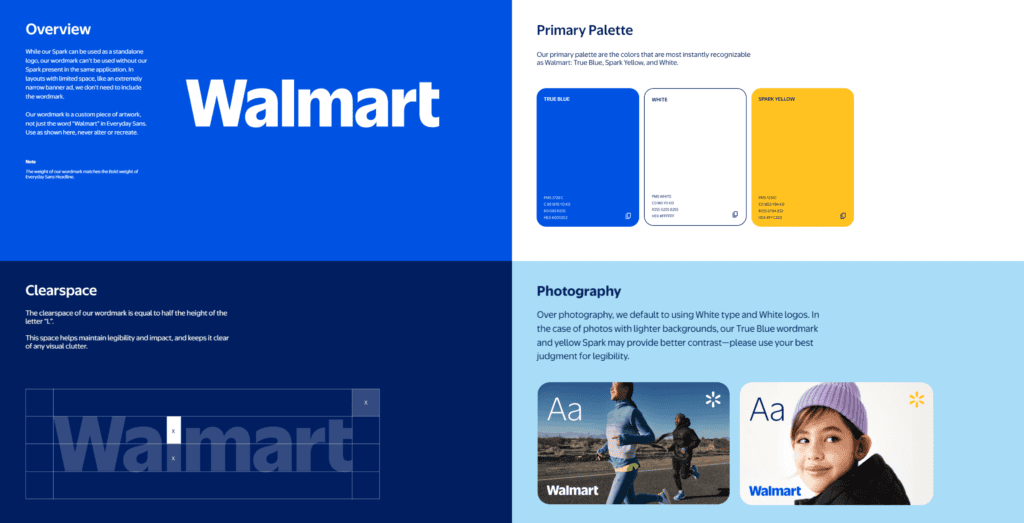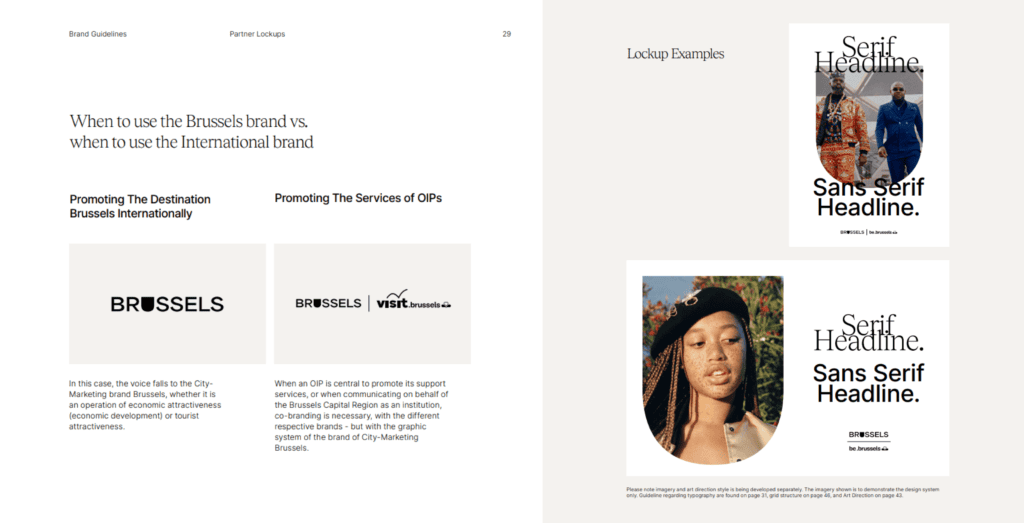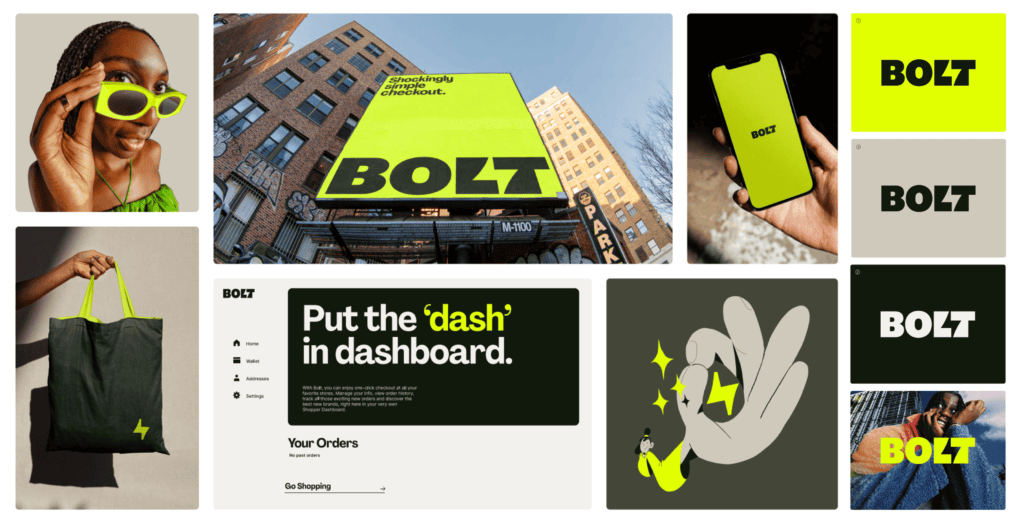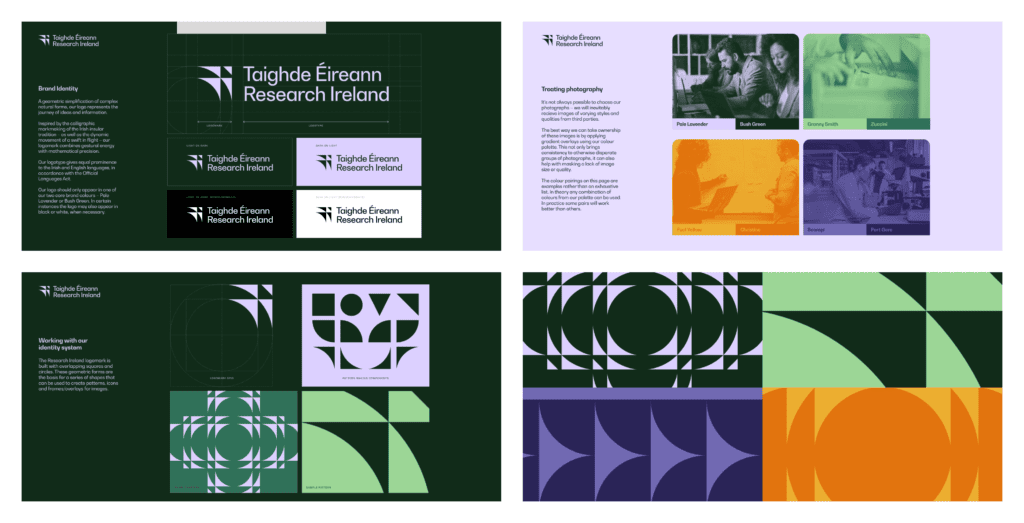Outline:
In today’s hyper-connected digital world, your brand is a catchy tagline. It’s the sum of every interaction, every visual cue, and every message your audience encounters. Without a clear roadmap to guide these elements, brands risk inconsistency, confusion, and, ultimately, losing customer trust. This is where creating brand guidelines comes into play—a process that ensures every piece of communication aligns with your brand’s core identity.
Think of a brand style guide as the DNA of your brand. It dictates how your business is represented visually, verbally, and emotionally, ensuring consistency and professionalism at every touchpoint. Whether you’re launching a startup or evolving an established business, knowing how to create brand guidelines can make the difference between a forgettable impression and a lasting connection with your audience.
A brand style guide serves as the ultimate playbook. It sets rules for how your logo is used, what tone your messaging should take, which colors to associate with your identity, and even the typography that supports your story. But these guidelines aren’t just for designers or marketers—they’re for anyone who interacts with your brand, from employees to partners. By creating brand guidelines, you ensure a unified presence across all channels and platforms, no matter who’s representing your company.
Demystifying Brand Guidelines
Before diving into the mechanics of how to create brand guidelines, it’s essential to understand what they are and why they’re pivotal to a brand’s success. A brand style guide, often referred to as brand guidelines, is a comprehensive document that outlines the rules and standards for presenting your brand across various platforms and mediums. It’s a roadmap for how your brand communicates visually and verbally.
What Exactly Are Brand Guidelines
At their core, brand guidelines are a set of instructions that ensure every interaction with your brand is cohesive and professional. They cover everything from logo placement to color schemes, typography, imagery, and tone of voice. But creating brand guidelines goes beyond just aesthetics—it’s about ensuring that your brand’s personality and values are consistently represented, whether in a social media post, an email campaign, or a billboard advertisement.
Unlike ad-hoc branding decisions, a well-constructed brand style guide eliminates guesswork. It provides clear rules and examples, maintaining that everyone—designers, marketers, content creators, and even external partners—can align their efforts with your brand’s identity.
How They Shape Perception Across Channels
Consistency breeds trust, and trust is the foundation of customer loyalty. Imagine encountering a brand that uses a different logo or tone of voice on its website than on its packaging or social media. That inconsistency can confuse or even alienate potential customers. With a strong brand style guide, every customer touchpoint tells the same cohesive story, reinforcing your brand’s professionalism and reliability.
For instance, when you’re creating brand guidelines, you define the graphic design aspects and the emotional resonance your brand should evoke. Should your tone be playful or formal? Is your color palette vibrant and energetic, or muted and sophisticated? These details ensure that your brand feels intentional and authentic, no matter where or how your audience encounters it.
Why Brand Guidelines Are More Than a Document
A brand style guide is not a static set of rules—it’s a living, evolving framework. As your brand grows, adapts to market changes, or enters new territories, your guidelines should evolve to reflect those shifts. This adaptability is crucial because a brand that stays stagnant risks becoming irrelevant.
At its best, creating brand guidelines is an exercise in defining your company’s DNA. It’s not just about controlling how your brand looks—it’s about maintaining the integrity of what your brand stands for.
The Core Reasons Every Brand Needs Guidelines
Consistency: The Foundation of Brand Loyalty
In a world where consumers are bombarded with countless messages daily, consistency is non-negotiable. A solid brand style guide ensures that every interaction with your brand feels cohesive and familiar, whether it’s a social media ad, a product label, or an email signature. Thus, you’re essentially building a system that guarantees every element of your brand speaks the same language, fostering trust and recognition among your audience.
Consistency helps your audience feel confident about your company. After all, people tend to trust what feels reliable. From the exact shade of blue in your logo to the tone of your Instagram captions, your brand style guide ensures there’s no room for misinterpretation.
Turning Visual and Verbal Unity Into Recognition
Think of the most iconic brands in the world—Nike, Apple, or Coca-Cola. What makes them instantly recognizable? Their logos, colors, fonts, and tone of voice. These companies didn’t achieve their global status by chance. They became household names by using strict guidelines to maintain consistency across all platforms.
So, with brand guidelines, you’re giving your business the tools to do the same. Over time, your audience will begin to associate your unique design elements and tone with your brand, making your messaging stand out in a crowded marketplace.
Streamlining Team Collaboration and External Partnerships
Whether you’re a small business with a lean team or a corporation with multiple departments, confusion about branding can cause delays, inconsistencies, and wasted effort. A detailed brand style guide eliminates guesswork and empowers your team to stay aligned. It’s especially useful for onboarding new employees or working with external agencies—everyone will be on the same page from day one.
Safeguarding Your Brand’s DNA in a Dynamic World
Markets evolve, trends shift, and consumer preferences change. Amid this constant flux, your brand style guide becomes the anchor that keeps your brand identity intact. By clearly defining your brand’s visual and verbal elements, you ensure that your business stays recognizable, even as you adapt to new challenges and opportunities.
The Bigger Picture: Building Long-Term Trust
Ultimately, the goal of creating brand guidelines is to build a foundation for trust. When your brand shows up consistently and authentically across all platforms, customers know what to expect—and that’s powerful. They feel confident investing in your products or services because they see your brand as professional, reliable, and aligned with their values.
Blueprint for Crafting Brand Guidelines from Scratch
Creating a brand style guide might seem like a daunting task, but when broken into steps, it’s a logical and rewarding process. Here’s how to create brand guidelines that make your brand identity consistent, recognizable, and adaptable.
Step 1: Start with the Soul of Your Brand
Every great brand starts with a solid foundation. To create impactful guidelines, you first need to define what your brand stands for.
- Mission, Vision, and Values
Your mission is your brand’s purpose—why you exist. Your vision outlines where you aspire to be in the future. Your values are the guiding principles behind your decisions. Together, these elements act as the compass for your brand style guide and ensure that your brand feels authentic.
- Brand Personality: Who Are You
Are you playful, professional, quirky, or bold? Defining your personality ensures your tone and visuals align with the emotions you want your audience to feel. When you’re creating brand guidelines, think of your brand as a person—what would they sound like? How would they dress?
- Target Audience: Speak Their Language
A brand that resonates knows its audience. Your brand style guide should reflect the preferences and expectations of your ideal customers. For example, a youthful audience might appreciate vibrant colors and a casual tone, while a corporate audience may prefer muted colors and a professional approach.
Step 2: Master the Visual Language of Your Brand
Your visual identity is the face of your brand. Every element should reflect your mission and values.
- Logo Usage
Your logo is the cornerstone of your visual identity. Define rules for its size, spacing, and placement to ensure consistency. For example, specify whether it can be used on colored backgrounds, what constitutes acceptable variations, and what is strictly off-limits. Include visual examples in your brand style guide for clarity.
- Color Palette
Colors evoke emotions and create associations. Choose a palette that aligns with your brand’s personality. Divide your palette into primary (core brand colors) and secondary (supporting shades) categories. Provide HEX, RGB, and CMYK codes to avoid discrepancies.
Example: Spotify uses a vibrant green to reflect energy and creativity, paired with black for balance.
- Typography
Fonts speak volumes. Define your typography hierarchy—headlines, subheadings, body text, and captions. Specify approved font families, sizes, and spacing to create a unified look.
Tip: Pair a modern sans-serif font for headlines with a clean serif font for body text to achieve balance.
- Imagery and Photography
Whether it’s sleek product shots or whimsical illustrations, outline the style, tone, and content of imagery. For example, a tech brand might favor clean, futuristic visuals, while a wellness brand might lean toward warm, natural photography.
Step 3: Speak Your Truth—Tone of Voice and Messaging Rules
Visuals capture attention, but your words build relationships.
- Tone and Voice
Define your brand’s voice—formal, friendly, authoritative, playful, or empathetic. Then, establish your tone, which can vary based on context. For example, your social media tone might be more conversational, while your white papers could be more professional.
- Key Phrases and Taglines
Include phrases and taglines that capture your brand’s essence. For example, Nike’s “Just Do It” is more than a slogan—it’s a mantra that guides its messaging.
- Do’s and Don’ts of Messaging
Provide clear examples of acceptable language and phrases to avoid. For instance, a sustainable fashion brand might emphasize “ethically sourced” over “cheap.”
Step 4: Build Digital Consistency
In today’s world, your digital presence is often the first point of contact for your audience. Make sure your brand is represented consistently across platforms.
- Social Media Guidelines
Outline platform-specific rules for visuals, captions, hashtags, and responses to comments. For example, maintain a cohesive grid aesthetic on Instagram while using LinkedIn for thought leadership.
- Website Design Principles
Define standards for your website’s layout, navigation, and content hierarchy. Include rules for using white space, button styles, and typography to create a seamless user experience.
- Email Templates
Standardize email designs, including headers, footers, fonts, and signature formats. This ensures professional communication at every touchpoint.
Step 5: Craft Content Creation Standards
Content is the lifeblood of your brand’s communication. Ensure it aligns with your guidelines.
- Writing Style
Specify whether your tone is casual or formal, whether you use British or American spelling, and how you approach grammar and punctuation.
- Storytelling Framework
Create a structure for brand storytelling. Define how your brand’s journey, values, and customer impact should be communicated.
Step 6: Showcase Perfection Through Examples
A picture is worth a thousand words, especially in a brand style guide. Include mockups and real-life applications to clarify how the guidelines translate into practice. Including real-world examples in your brand style guide transforms abstract rules into practical tools.
- Logo Usage
Show examples of your logo in action—on packaging, websites, and merchandise. Include correct and incorrect applications to avoid misuse.
- Typography in Practice
Display how fonts should appear in headers, subheadings, and body text. Use mockups of flyers or social media posts to illustrate consistency.
- Color Palette
Provide examples of your brand colors in digital ads, landing pages, and print materials. Show how to use accent colors effectively.
- Imagery Standards
Include approved photo styles, such as high-energy images for fitness brands or minimalist shots for luxury brands, alongside examples to avoid.
- Tone of Voice
Offer sample captions, email headers, or product descriptions to demonstrate your brand’s personality in messaging.
- Platform Applications
Highlight examples from social media, email templates, and website layouts to show consistency across channels.
By combining these visuals and examples, your brand style guide becomes a powerful resource for maintaining your brand’s identity across every medium.
Essential Tools to Build and Maintain Your Brand Guidelines
Design Like a Pro: Tools for Crafting Visuals
Visual elements are at the heart of any brand style guide, and using the right design tools can significantly enhance your workflow. Here are some powerful tools to consider:
Adobe Creative Cloud
Industry-standard software like Photoshop, Illustrator, and InDesign for creating logos, color palettes, and layout mockups.
Figma
A collaborative, web-based design platform ideal for creating interactive prototypes and sharing designs with teams.
Canva
A beginner-friendly platform with drag-and-drop functionality and ready-to-use branding templates for social media, presentations, and more.
Sketch
A go-to tool for UI/UX designers, particularly effective for web and app design.
When choosing design tools, prioritize those that allow you to export assets in multiple formats, like PNGs for logos and SVGs for scalable visuals, to ensure versatility in your brand style guide.
Collaborate Without Confusion: Platforms for Team Alignment
Creating and maintaining brand guidelines requires input and collaboration across teams. The following platforms simplify communication and organization:
Notion
A versatile tool for organizing content drafts, feedback, and timelines in one unified workspace.
Google Workspace
Ideal for collaborative editing and storing guidelines, templates, and approved assets.
Trello
A visual project management tool that helps teams track progress and stay aligned on branding tasks.
Slack
Great for real-time communication and quick clarifications during the guideline creation process.
Showcase Your Guidelines with Intuitive Platforms
Static PDFs of brand guidelines are becoming outdated. Interactive, easily accessible platforms are now the preferred way to store and share your guidelines. Consider these options:
Frontify
A comprehensive tool for building and hosting brand guidelines. Includes features for asset storage, logo versions, and color palettes.
Brandfolder
A digital asset management platform that centralizes your brand materials and ensures consistency across teams.
Lucidpress
Offers editable templates and design tools while allowing teams to maintain alignment with your brand style guide.
Interactive platforms allow real-time updates, ensuring your team always works with the most current version of the guidelines.
Keep Your Brand Guidelines Evolving
A good brand style guide is never static. It grows and adapts with your brand. To ensure your guidelines stay relevant, use tools that offer version control and regular updates:
Airtable
A database tool to track branding updates, changes, and team responsibilities.
Dropbox or OneDrive
Cloud storage solutions for organizing and accessing guideline assets globally.
Confluence
A knowledge-sharing platform where teams can document updates and provide feedback on guideline adjustments.
Ensuring Your Brand Guidelines Live and Breathe
Make Your Guidelines Accessible
A brand style guide is only effective if everyone can access it. Use cloud-based platforms like Frontify or Notion to share the document and integrate it into project workflows. Create a quick-start version for new team members or partners.
Train Teams to Apply the Rules
Host workshops or webinars to walk teams through the guidelines. Provide cheat sheets and encourage practice with mock projects to reinforce the rules.
Maintain Consistency
Assign a brand manager to review assets and ensure compliance. Use tools like Canva for Teams or Adobe Libraries for pre-approved templates, and conduct regular brand audits to fix inconsistencies.
Update as Your Brand Evolves
Keep the guide dynamic by updating it as your brand grows. Add sections for new platforms, campaigns, or audiences, and clearly log changes so everyone stays aligned.
Celebrate Successes
Highlight campaigns or team members who effectively implement the guide, showing how consistency drives results.
Iconic Branding in Practice: Lessons from the Pros
Walmart: Minimalism and Precision
Walmart’s brand style guide is a masterclass in clarity and consistency. Its use of clean, bold typography, a distinctive blue and yellow color palette, and structured layouts ensures a recognizable and cohesive identity across all platforms. Every element, from in-store signage to digital marketing, aligns with its branding playbook.
Takeaway: Clarity is key. Keep your guidelines concise and focused on essential elements to avoid overwhelming your team.

Brussels: Emotion in Every Element
Brussels, as a brand, thrives on evoking a strong sense of culture, tradition, and vibrancy. Whether in tourism campaigns, official city branding, or promotional materials, its rich color schemes, dynamic imagery, and engaging messaging reflect a well-crafted identity. The brand style guide ensures that Brussels’ cultural heritage remains visually and emotionally consistent.
Takeaway: Define how your brand’s tone and visuals should inspire your audience. Emotion-driven guidelines foster stronger connections.

Bolt: Consistency Across Markets
Bolt’s rapid global expansion requires branding that remains adaptable while retaining a strong identity. From its signature green color to its bold, straightforward messaging, Bolt’s branding ensures instant recognition across different regions. The brand guidelines cover everything from app UI elements to marketing materials, ensuring a unified yet flexible identity.
Takeaway: Create adaptable guidelines that work across different regions and platforms without losing the essence of your brand.

Slantis: A Future-Driven Brand Identity
Slantis, a rising force in the tech industry, has built its brand identity around innovation and forward-thinking design. Its guidelines emphasize sleek typography, modern iconography, and a futuristic color palette that reinforces its cutting-edge reputation. By maintaining strict brand consistency, Slantis ensures its visual identity aligns with its tech-driven vision.
Takeaway: A well-defined brand identity should reflect your company’s vision and values, helping it stand out in a competitive market.

Research Ireland: Authority and Trust in Branding
Research Ireland’s branding is built on credibility, trust, and academic excellence. Its style guide ensures a professional yet approachable tone across all materials, from research publications to digital assets. With a strong emphasis on typography, a balanced color palette, and structured layouts, Research Ireland maintains authority and recognition in its field.
Takeaway: A strong brand style guide helps establish trust and professionalism, ensuring that every touchpoint reflects your expertise.

On a Final Note
Crafting a brand style guide is a crucial step in ensuring your brand remains consistent, recognizable, and impactful across all platforms. From defining your brand’s identity to establishing clear rules for visuals and messaging, a well-constructed guide creates a unified playbook for your team and partners, building trust and loyalty with your audience.
Remember, a great brand style guide is a living resource that evolves with your brand. Whether you’re starting from scratch or refining your existing guidelines, take the first step today and let us help you create a cohesive, memorable brand identity—contact us to get started.





